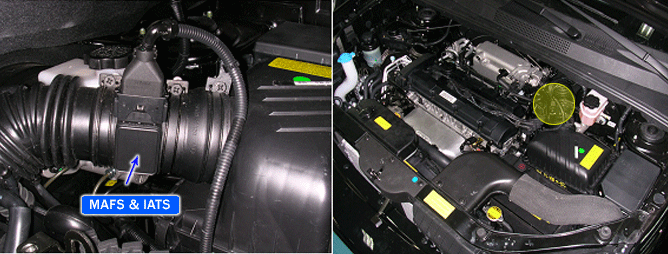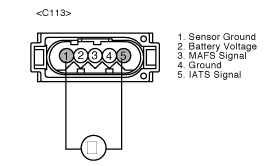Has a problem been found?

▶ Repair as necessary and go to "Verification of Vehicle Repair" procedure.

▶ Go to "Component Inspection" procedure .

The Intake Air Temperature Sensor (IATS) is installed into the Mass Air Flow Sensor (MAFS). The IATS uses a thermistor whose resistance changes with the temperature. The electrical resistance of the IATS decreases as the temperature increases, and increases as the temperature decreases. The 5 V power source in the PCM is supplied to the IATS via a resistor in the PCM. That is, the resistor in the PCM and the thermistor in the IATS are connected in series. When the resistance value of the thermistor in IATS changes according to the intake air temperature, the signal voltage also changes. Using this signal, the information of the intake air temperature, the PCM corrects basic fuel injection duration and ignition timing.
The purpose of this diagnosis is to detect a stuck intake air temperature signal. The diagnostic function checks whether after a variation of the calculated intake air temperature also a variation of the measured intake air temperature is detected.PCM sets DTC P0111 when the variation of measured intake air temperature from engine start is smaller than threshold while variation of calculated intake air temperature by PCM is greater than threshold.
Item | Detecting Condition | Possible Cause |
DTC Strategy | ● Check intake air temperature signal stuck. | ● Contact resistance in connections. ● Faulty IAT sensor |
Enable Conditions | ● Time after engine start > 300sec. ● Coolant temp. > 76℃(169℉) ● Coolant temp. increasing after start > 40℃(104℉) ● Vehicle speed < 5km/h(3 mph) ● No relevant failure | |
Threshold value | ● Difference between intake air temp. at stat and minimum air temp. < 1.5℃(34.7℉) and difference between maximum air temp. and intake air temp. at stat and <1.5℃(34.7℉) | |
Diagonostic Time | ● 5 sec. |
Temp.(°C) | Temp.(°F) | Resistance(kΩ) | Temp.(°C) | Temp.(°F) | Resistance(kΩ) |
-20 | -4 | 14.26 ~ 16.02 | 40 | 104 | 1.11 ~ 1.19 |
0 | 32 | 5.50 ~ 6.05 | 60 | 140 | 0.57 ~ 0.60 |
20 | 68 | 2.35 ~ 2.54 | 80 | 176 | 0.31 ~ 0.32 |

Many malfunctions in the electrical system are caused by poor harness(es) and terminals. Faults can also be caused by interference from other electrical systems, and mechanical or chemical damage.
Thoroughly check connectors for looseness, poor connection, bending, corrosion, contamination, deterioration, or damage.
Has a problem been found?

▶ Repair as necessary and go to "Verification of Vehicle Repair" procedure.

▶ Go to "Component Inspection" procedure .
Ignition "OFF"
Disconnect IATS connector.
Measure resistance between terminals 1 and 5 of the sensor connector(Component side).
Temp.(°C) | Temp.(°F) | Resistance(kΩ) | Temp.(°C) | Temp.(°F) | Resistance(kΩ) |
-20 | -4 | 14.26 ~ 16.02 | 40 | 104 | 1.11 ~ 1.19 |
0 | 32 | 5.50 ~ 6.05 | 60 | 140 | 0.57 ~ 0.60 |
20 | 68 | 2.35 ~ 2.54 | 80 | 176 | 0.31 ~ 0.32 |

Is resistance within the specification?

▶ Check for poor connection between PCM and component: backed out terminal, improper mating, broken locks or poor terminal to wire connection. Repair as necessary and go to "Verification of Vehicle Repair" procedure.

▶ Check IATS for contamination, deterioration, or damage. Substitute with a known-good IATS and check for proper operation. If the problem is corrected, replace IATS and then go to "Verification of Vehicle Repair" procedure.
After a repair, it is essential to verify that the fault has been corrected.
Connect scan tool and select "Diagnostic Trouble Codes(DTCs)" mode.
Press F4(DTAL) and confirm that "DTC Readiness Flag" indicates "Complete". If not, drive the vehicle within conditions noted in the freeze frame data or enable conditions
Read "DTC Status" parameter
Is parameter displayed "History(Not Present) fault"?

▶ System performing to specification at this time. Clear the DTC

▶ Go to the applicable troubleshooting procedure.